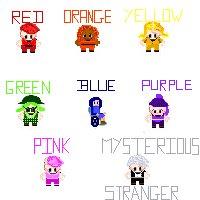
Colours (Nintendo Switch) - Evelyn Sanger-Davies (13) & Jessica Nunn-Wright (14), Sleaford, Lincolnshire
“You wake up as a different person each day for seven days and have to fit in as them whilst trying to find out information about a mysterious person that keeps appearing and seems to know everything about you: eat sleep repeat but not in this game.”
Each of the seven playable characters is assigned a colour. At the start screen, you choose a colour (the level). The first colour you choose changes the ending. At the start of the game, you see someone who seems to know everything about what is happening and gives you the tutorial. Then, you get given a secret aim to find out who this mysterious stranger is. If you figure it out, you get a different ending to the others.
When you wake up as the person, you don't know anything about them, but on the first level you find out you have to fit in as them. You find out information about them through items, diaries and sometimes narrative dialogue. In each level, there is different challenges due to the different personalities and living conditions of each person you switch to. Here is a list of the colours, personality traits, and disability/ issue:
Red Calm at first but then fierce Anger issues
Orange Strong opinions OCD
Yellow Happy but hiding something Depression from split parents
Green Laid back, seems messy Visually Impaired
Blue Calm Wheelchair bound
Purple Sassy, popular Anxiety from peer pressure
Pink Shy Trans and is bullied for it
Our game is a retro indie game, the colour scheme varies depending on the level. The 'overworld' (when you're moving around the room) is like the retro games but when you talk to or interact with someone/something the camera zooms in so you can see them in higher definition and up close in first person. The other characters which you interact with are the colour which contrasts the main colour of the level, showing the difference that each of the characters feel to other people.
On the Nintendo Switch, you can use the left stick to move, the A button to interact with things and the B button to go back. We decided that the game controls should be as simple as possible, so the game is available to play by people of all ages and abilities.
Our target audience would be people who are curious about what life is like for different people, but this game can be played by anyone, as the mystery of the stranger can draw in theorists. This game can draw in a lot of people, as there is lots of representation. They would be people who are into indie games and miss the graphic of older games. This is a growing group of people, so it would appeal to the growing market.

